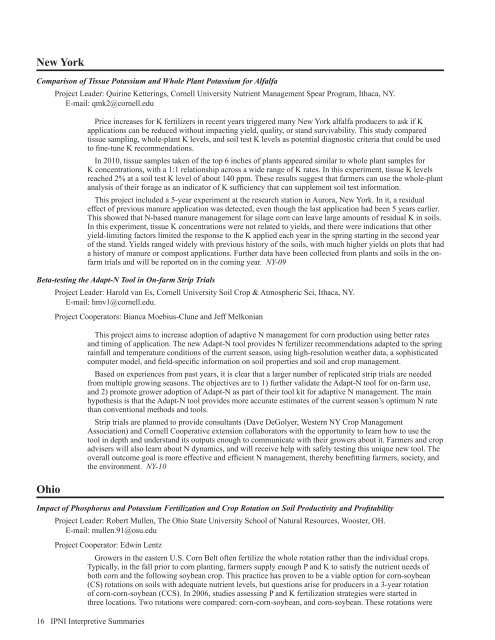Americas and Oceania Group - International Plant Nutrition Institute
Americas and Oceania Group - International Plant Nutrition Institute
Americas and Oceania Group - International Plant Nutrition Institute
Create successful ePaper yourself
Turn your PDF publications into a flip-book with our unique Google optimized e-Paper software.
New York<br />
Comparison of Tissue Potassium <strong>and</strong> Whole <strong>Plant</strong> Potassium for Alfalfa<br />
Project Leader: Quirine Ketterings, Cornell University Nutrient Management Spear Program, Ithaca, NY.<br />
E-mail: qmk2@cornell.edu<br />
Price increases for K fertilizers in recent years triggered many New York alfalfa producers to ask if K<br />
applications can be reduced without impacting yield, quality, or st<strong>and</strong> survivability. This study compared<br />
tissue sampling, whole-plant K levels, <strong>and</strong> soil test K levels as potential diagnostic criteria that could be used<br />
to fine-tune K recommendations.<br />
In 2010, tissue samples taken of the top 6 inches of plants appeared similar to whole plant samples for<br />
K concentrations, with a 1:1 relationship across a wide range of K rates. In this experiment, tissue K levels<br />
reached 2% at a soil test K level of about 140 ppm. These results suggest that farmers can use the whole-plant<br />
analysis of their forage as an indicator of K sufficiency that can supplement soil test information.<br />
This project included a 5-year experiment at the research station in Aurora, New York. In it, a residual<br />
effect of previous manure application was detected, even though the last application had been 5 years earlier.<br />
This showed that N-based manure management for silage corn can leave large amounts of residual K in soils.<br />
In this experiment, tissue K concentrations were not related to yields, <strong>and</strong> there were indications that other<br />
yield-limiting factors limited the response to the K applied each year in the spring starting in the second year<br />
of the st<strong>and</strong>. Yields ranged widely with previous history of the soils, with much higher yields on plots that had<br />
a history of manure or compost applications. Further data have been collected from plants <strong>and</strong> soils in the onfarm<br />
trials <strong>and</strong> will be reported on in the coming year. NY-09<br />
Beta-testing the Adapt-N Tool in On-farm Strip Trials<br />
Ohio<br />
Project Leader: Harold van Es, Cornell University Soil Crop & Atmospheric Sci, Ithaca, NY.<br />
E-mail: hmv1@cornell.edu.<br />
Project Cooperators: Bianca Moebius-Clune <strong>and</strong> Jeff Melkonian<br />
This project aims to increase adoption of adaptive N management for corn production using better rates<br />
<strong>and</strong> timing of application. The new Adapt-N tool provides N fertilizer recommendations adapted to the spring<br />
rainfall <strong>and</strong> temperature conditions of the current season, using high-resolution weather data, a sophisticated<br />
computer model, <strong>and</strong> field-specific information on soil properties <strong>and</strong> soil <strong>and</strong> crop management.<br />
Based on experiences from past years, it is clear that a larger number of replicated strip trials are needed<br />
from multiple growing seasons. The objectives are to 1) further validate the Adapt-N tool for on-farm use,<br />
<strong>and</strong> 2) promote grower adoption of Adapt-N as part of their tool kit for adaptive N management. The main<br />
hypothesis is that the Adapt-N tool provides more accurate estimates of the current season’s optimum N rate<br />
than conventional methods <strong>and</strong> tools.<br />
Strip trials are planned to provide consultants (Dave DeGolyer, Western NY Crop Management<br />
Association) <strong>and</strong> Cornell Cooperative extension collaborators with the opportunity to learn how to use the<br />
tool in depth <strong>and</strong> underst<strong>and</strong> its outputs enough to communicate with their growers about it. Farmers <strong>and</strong> crop<br />
advisers will also learn about N dynamics, <strong>and</strong> will receive help with safely testing this unique new tool. The<br />
overall outcome goal is more effective <strong>and</strong> efficient N management, thereby benefitting farmers, society, <strong>and</strong><br />
the environment. NY-10<br />
Impact of Phosphorus <strong>and</strong> Potassium Fertilization <strong>and</strong> Crop Rotation on Soil Productivity <strong>and</strong> Profitability<br />
Project Leader: Robert Mullen, The Ohio State University School of Natural Resources, Wooster, OH.<br />
E-mail: mullen.91@osu.edu<br />
Project Cooperator: Edwin Lentz<br />
Growers in the eastern U.S. Corn Belt often fertilize the whole rotation rather than the individual crops.<br />
Typically, in the fall prior to corn planting, farmers supply enough P <strong>and</strong> K to satisfy the nutrient needs of<br />
both corn <strong>and</strong> the following soybean crop. This practice has proven to be a viable option for corn-soybean<br />
(CS) rotations on soils with adequate nutrient levels, but questions arise for producers in a 3-year rotation<br />
of corn-corn-soybean (CCS). In 2006, studies assessing P <strong>and</strong> K fertilization strategies were started in<br />
three locations. Two rotations were compared: corn-corn-soybean, <strong>and</strong> corn-soybean. These rotations were<br />
16 IPNI Interpretive Summaries

















